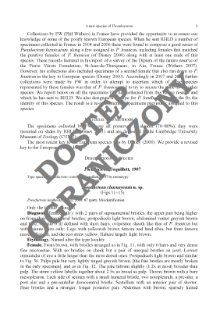- Search in all Repository
- Literature and maps
- Archeology
- Mills database
- Natural sciences
Advanced search
Advanced search
Advanced search
Advanced search
Advanced search

Object
Title: Fossil mayfly collections of the Museum für Naturkunde, Humboldt University, Berlin. 2, Redescription of Baltameletus oligocaenicus Demoulin, 1968 with notes on Ameletidae McCafferty, 1991 (Insecta: Ephemeroptera) from the Eocene Baltic amber
Creator:
Godunko, Roman J. ; Neumann, Christian ; Krzemiński, Wiesław
Date issued/created:
Resource type:
Subtitle:
Annales Zoologici, vol. 58, no 1 ; Redescription of Baltameletus oligocaenicus Demoulin, 1968 with notes on Ameletidae McCafferty, 1991 (Insecta: Ephemeroptera) from the Eocene Baltic amber
Contributor:
Muzeum i Instytut Zoologii Polskiej Akademii Nauk
Publisher:
Place of publishing:
Description:
Bibliogr. p. 113-114 ; P. 105-114 : ill. ; 27 cm ; Taxa in Latin
Type of object:
Abstract:
The holotype of Baltameletus oligocaenicus Demoulin, 1968 preserved in Eocene Baltic amber and housed in the W. Simon amber collection at the Museum für Naturkunde, Humboldt University, Berlin is redescribed and illustrated. Baltameletus Demoulin, 1968 can be attributed to the family Ameletidae McCafferty, 1991 by a combinationof following characteristics: (1) lateroparapsidal suture of mesothorax relatively elongate; (2) epimeron of mesothorax with membranous area between anepimeron andkatepimeron; (3) mesonotal suture stretched backward medially and anterior paracoxalsuture complete; (4) furcasternal protuberances contiguous; (5) hind wings well developed with RS, MA and MP triads; (6) tarsi 5-segmented with first tarsal segment fused with tibia; (7) forceps with two distal segments; (8) all tarsal claws dissimilar. This fossil genus clearly differs from all other representatives of the family Ameletidae by the following combinationof characteristics: (1) unpaired projection of the vertex; (2) dorsally contiguous compound eyes (3); 2–3 mainly simple veins stretching from CuA to basitornal margin of forewing. Additionally, some data on the fossil representatives of Ameletidae are given.
Relation:
Volume:
Issue:
Start page:
End page:
Detailed Resource Type:
Format:
Resource Identifier:
Source:
MiIZ PAN, call no. P.255, vol 58, no 1 ; MiIZ PAN, call no. P.4314, vol 58, no 1 ; click here to follow the link
Language:
Language of abstract:
Rights:
Rights Reserved - Restricted Access
Terms of use:
Digitizing institution:
Museum and Institute of Zoology of the Polish Academy of Sciences
Original in:
Library of the Museum and Institute of Zoology of the Polish Academy of Sciences
Projects co-financed by:
Programme Innovative Economy, 2010-2014, Priority Axis 2. R&D infrastructure ; European Union. European Regional Development Fund
Access:
Object collections:
- Digital Repository of Scientific Institutes > Partners' collections > Museum and Institute of Zoology PAS > Scientific Journals
- Digital Repository of Scientific Institutes > Partners' collections > Museum and Institute of Zoology PAS > MIZ PAN Publications > Annales Zoologici
- Digital Repository of Scientific Institutes > Literature > Journals/Articles
Last modified:
Feb 4, 2025
In our library since:
Apr 26, 2016
Number of object content downloads / hits:
72
All available object's versions:
https://rcin.org.pl./publication/55614
Show description in RDF format:
Show description in RDFa format:
Show description in OAI-PMH format:
Objects Similar
Godunko, Roman J. Neumann, Christian
Klûge, Nikita Ûl'evič Godunko, Roman J. Krzemiński, Wiesław
Godunko, Roman J. Kłonowska-Olejnik, Małgorzata
Godunko, Roman J. Sontag, Elżbieta
Szwedo, Jacek Stroiński, Adam
Woźnica, Andrzej Józef
Godunko, Roman J. Kłonowska-Olejnik, Małgorzata Soldán, Tomáš
Soldán, Tomáš Godunko, Roman J.

 INSTYTUT ARCHEOLOGII I ETNOLOGII POLSKIEJ AKADEMII NAUK
INSTYTUT ARCHEOLOGII I ETNOLOGII POLSKIEJ AKADEMII NAUK
 INSTYTUT BADAŃ LITERACKICH POLSKIEJ AKADEMII NAUK
INSTYTUT BADAŃ LITERACKICH POLSKIEJ AKADEMII NAUK
 INSTYTUT BADAWCZY LEŚNICTWA
INSTYTUT BADAWCZY LEŚNICTWA
 INSTYTUT BIOLOGII DOŚWIADCZALNEJ IM. MARCELEGO NENCKIEGO POLSKIEJ AKADEMII NAUK
INSTYTUT BIOLOGII DOŚWIADCZALNEJ IM. MARCELEGO NENCKIEGO POLSKIEJ AKADEMII NAUK
 INSTYTUT BIOLOGII SSAKÓW POLSKIEJ AKADEMII NAUK
INSTYTUT BIOLOGII SSAKÓW POLSKIEJ AKADEMII NAUK
 INSTYTUT CHEMII FIZYCZNEJ PAN
INSTYTUT CHEMII FIZYCZNEJ PAN
 INSTYTUT CHEMII ORGANICZNEJ PAN
INSTYTUT CHEMII ORGANICZNEJ PAN
 INSTYTUT FILOZOFII I SOCJOLOGII PAN
INSTYTUT FILOZOFII I SOCJOLOGII PAN
 INSTYTUT GEOGRAFII I PRZESTRZENNEGO ZAGOSPODAROWANIA PAN
INSTYTUT GEOGRAFII I PRZESTRZENNEGO ZAGOSPODAROWANIA PAN
 INSTYTUT HISTORII im. TADEUSZA MANTEUFFLA POLSKIEJ AKADEMII NAUK
INSTYTUT HISTORII im. TADEUSZA MANTEUFFLA POLSKIEJ AKADEMII NAUK
 INSTYTUT JĘZYKA POLSKIEGO POLSKIEJ AKADEMII NAUK
INSTYTUT JĘZYKA POLSKIEGO POLSKIEJ AKADEMII NAUK
 INSTYTUT MATEMATYCZNY PAN
INSTYTUT MATEMATYCZNY PAN
 INSTYTUT MEDYCYNY DOŚWIADCZALNEJ I KLINICZNEJ IM.MIROSŁAWA MOSSAKOWSKIEGO POLSKIEJ AKADEMII NAUK
INSTYTUT MEDYCYNY DOŚWIADCZALNEJ I KLINICZNEJ IM.MIROSŁAWA MOSSAKOWSKIEGO POLSKIEJ AKADEMII NAUK
 INSTYTUT PODSTAWOWYCH PROBLEMÓW TECHNIKI PAN
INSTYTUT PODSTAWOWYCH PROBLEMÓW TECHNIKI PAN
 INSTYTUT SLAWISTYKI PAN
INSTYTUT SLAWISTYKI PAN
 SIEĆ BADAWCZA ŁUKASIEWICZ - INSTYTUT TECHNOLOGII MATERIAŁÓW ELEKTRONICZNYCH
SIEĆ BADAWCZA ŁUKASIEWICZ - INSTYTUT TECHNOLOGII MATERIAŁÓW ELEKTRONICZNYCH
 MUZEUM I INSTYTUT ZOOLOGII POLSKIEJ AKADEMII NAUK
MUZEUM I INSTYTUT ZOOLOGII POLSKIEJ AKADEMII NAUK
 INSTYTUT BADAŃ SYSTEMOWYCH PAN
INSTYTUT BADAŃ SYSTEMOWYCH PAN
 INSTYTUT BOTANIKI IM. WŁADYSŁAWA SZAFERA POLSKIEJ AKADEMII NAUK
INSTYTUT BOTANIKI IM. WŁADYSŁAWA SZAFERA POLSKIEJ AKADEMII NAUK




































